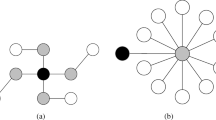Abstract
Density peak algorithm is a widely accepted density-based clustering algorithm, which shows excellent performance for the discrete data with any shape, any distribution and any density. However, the traditional density peak model is suitable for the complex network. To solve this problem, an enhanced density peak-based community detection algorithm is proposed in this paper, simply called DPCD. Firstly, a novel local density suitable for complex networks is defined to jointly consider the node distribution and network structure. Secondly, based on the node density and network structure, a density connected tree is constructed to measure a density following distance of each node. Finally, an improved density peak model is constructed to quickly and accurately cluster complex networks. Experiments on multiple synthetic networks and real networks show that our DPCD algorithm offers better community detection results.











Similar content being viewed by others
Availability of data and materials
All data generated or analysed during this study are included in this published article [and its supplementary information files]. Code availability: Code will be made available once the paper is accepted.
References
Bhat, S.Y., & Abulais, M. (2015). Ocminer: a density-based overlapping community detection method for social networks. Intelligent Data Analysis, 19(4), 917–947.
Cheng, J., Wang, X., Gong, W., Li, J., Chen, N., & Chen, X. (2021). Community detection based on density peak clustering model and multiple attribute decision-making strategy topsis. Complexity, 2021.
Chouchani, N., & Abed, M. (2020). Online social network analysis: detection of communities of interest. Journal of Intelligent Information Systems, 54 (1), 5–21.
Clauset, A., Newman, M.E., & Moore, C. (2004). Finding community structure in very large networks. Physical Review E, 70(6), 066111.
Deng, Z. -H., Qiao, H. -H., Gao, M. -Y., Song, Q., & Gao, L. (2019). Complex network community detection method by improved density peaks model. Physica A: Statistical Mechanics and its Applications, 526, 121070.
Garza, S.E., & Schaeffer, S.E. (2019). Community detection with the label propagation algorithm: a survey. Physica A: Statistical Mechanics and its Applications, 534, 122058.
Guo, J., Singh, P., & Bassler, K.E. (2020). Resolution limit revisited: community detection using generalized modularity density. arXiv:http://arxiv.org/abs/2012.14543.
Javed, M.A., Younis, M.S., Latif, S., Qadir, J., & Baig, A. (2018). Community detection in networks: a multidisciplinary review. Journal of Network and Computer Applications, 108, 87–111.
Jin, D., Yu, Z., Jiao, P., Pan, S., He, D., Wu, J., Yu, P., & Zhang, W. (2021). A survey of community detection approaches: From statistical modeling to deep learning. IEEE Transactions on Knowledge and Data Engineering.
Kumar, S., Panda, B., & Aggarwal, D. (2021). Community detection in complex networks using network embedding and gravitational search algorithm. Journal of Intelligent Information Systems, 57(1), 51–72.
Li, Z., & Tang, Y. (2018). Comparative density peaks clustering. Expert Systems with Applications, 95, 236–247.
Liu, D., Su, Y., Li, X., & Niu, Z. (2017). A novel community detection method based on cluster density peaks. In National CCF conference on natural language processing and chinese computing (pp. 515–525). Springer.
Lu, H., Shen, Z., Sang, X., Zhao, Q., & Lu, J. (2020). Community detection method using improved density peak clustering and nonnegative matrix factorization. Neurocomputing, 415, 247–257.
Mohamed, E. -M., Agouti, T., Tikniouine, A., & El Adnani, M. (2019). A comprehensive literature review on community detection: approaches and applications. Procedia Computer Science, 151, 295–302.
Newman M.E, & Girvan M. (2004). Finding and evaluating community structure in networks. Physical Review E, 69(2), 026113.
Raghavan, U.N., Albert, R., & Kumara, S. (2007). Near linear time algorithm to detect community structures in large-scale networks. Physical Review E, 76(3), 036106.
Rand, W.M. (1971). Objective criteria for the evaluation of clustering methods. Journal of the American Statistical Association, 66(336), 846–850.
Rodriguez, A., & Laio, A. (2014). Clustering by fast search and find of density peaks. Science, 344(6191), 1492–1496.
Sun, Z., Wang, B., Sheng, J., Yu, Z., Zhou, R., & Shao, J. (2019). Community detection based on information dynamics. Neurocomputing, 359, 341–352.
Van Lierde, H., Chow, T.W., & Chen, G. (2019). Scalable spectral clustering for overlapping community detection in large-scale networks. IEEE Transactions on Knowledge and Data Engineering, 32(4), 754–767.
Wen, D., Qin, L., Zhang, Y., Chang, L., & Lin, X. (2017). Efficient structural graph clustering: an index-based approach. Proceedings of the VLDB Endowment, 11(3), 243–255.
Yao, K., Papadias, D., & Bakiras, S. (2019). Density-based community detection in geo-social networks. In Proceedings of the 16th international symposium on spatial and temporal databases, pp. 110–119.
Zhang, Z., Pu, P., Han, D., & Tang, M. (2018). Self-adaptive louvain algorithm: fast and stable community detection algorithm based on the principle of small probability event. Physica A: Statistical Mechanics and its Applications, 506, 975–986.
Zhu, J., Chen, B., & Zeng, Y. (2020). Community detection based on modularity and k-plexes. Information Sciences, 513, 127–142.
Funding
This work is supported by the National Natural Science Foundation of China (No.62103143); Hunan Provincial Natural Science Foundation of China (No.2020JJ5199); the National Defense Basic Research Program of China (No.JCKY2019403D006); the National Key Research and Development Program (No.2019YFE0105300/2019YFE0118700); the Scientific Research Fund of Hunan Provincial Education Department (No.20C0786); and the Open Project of Key Laboratory of Intelligent Computing and Information Processing of Ministry of Education, Xiangtan University (2020ICIP06).
Author information
Authors and Affiliations
Corresponding author
Ethics declarations
Consent to participate
All the authors listed have approved the manuscript that is enclosed.
Consent for Publication
I would like to declare on behalf of my co-authors that the work described was original research that has not been published previously, and is not under consideration for publication elsewhere, in whole or in part.
Conflict of Interests
The authors declare that they have no conflict of interest.
Additional information
Publisher’s note
Springer Nature remains neutral with regard to jurisdictional claims in published maps and institutional affiliations.
Rights and permissions
About this article
Cite this article
Chen, L., Zheng, H., Li, Y. et al. Enhanced density peak-based community detection algorithm. J Intell Inf Syst 59, 263–284 (2022). https://doi.org/10.1007/s10844-022-00702-y
Received:
Revised:
Accepted:
Published:
Issue Date:
DOI: https://doi.org/10.1007/s10844-022-00702-y




